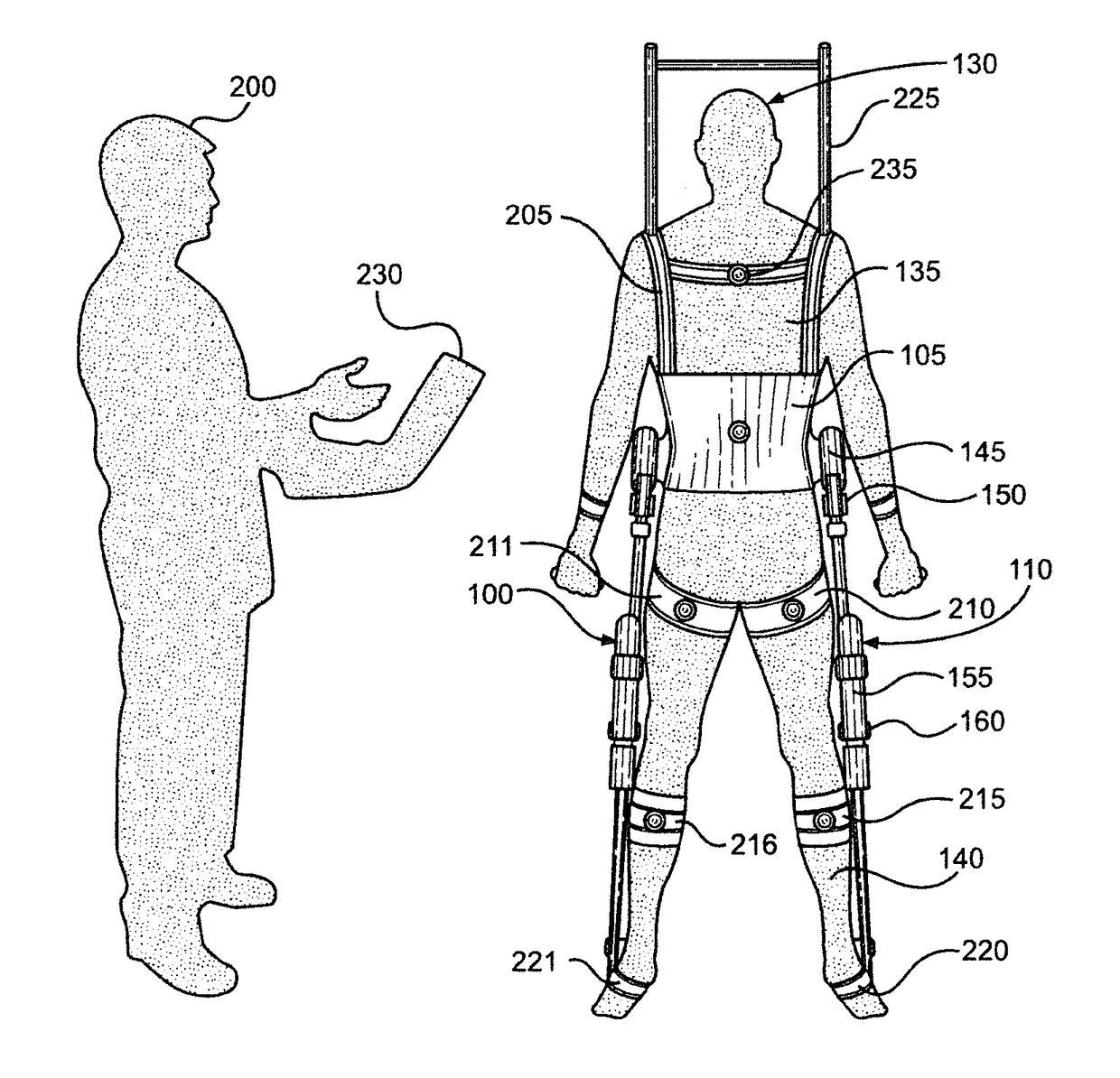Methods of Enhancing the Rehabilitation or Training of an Exoskeleton Wearer
a technology of exoskeleton and rehabilitation, applied in the field of methods of enhancing the rehabilitation or training of an exoskeleton wearer, can solve the problems of loss of function and other adverse conditions of the affected individual, additional negative physical and/or psychological outcomes impaired mobility of the afflicted individual, so as to improve the therapeutic benefit of exoskeleton therapy and better predict the trajectories of walking
- Summary
- Abstract
- Description
- Claims
- Application Information
AI Technical Summary
Benefits of technology
Problems solved by technology
Method used
Image
Examples
first embodiment
[0033]Turning to FIG. 2A, there is shown a physical therapist 200 observing patient 130 and exoskeleton 100 having a trunk portion (not separately labeled) in accordance with the present invention. As shown in this particular exoskeleton arrangement, patient 130 is coupled to exoskeleton 100 by torso brace 105, chest strapping 205, upper leg braces 210 and 211, lower leg braces 215 and 216 and foot braces 220 and 221. In some cases, depending on the rehabilitative state of patient 130, patient 130 and exoskeleton 100 are supported by a harness 225, which is connected to chest strapping 205. Physical therapist 200 uses a control or interface device 230, shown as a laptop in FIG. 2A, to transmit commands to the exoskeleton control system (e.g., controller 165) of exoskeleton 100 to cause exoskeleton 100 to engage in movements, with hip actuator 145 effecting movements about hip joint 150 and knee actuator 155 effecting movements about knee joint 160. When hip actuator 145 causes movem...
third embodiment
[0041]As an example of the third embodiment, consider a disabled person who is using an ambulatory exoskeleton outside of a physical therapy setting, such as in the home. If this person, who has no sensation below the waist, is using the exoskeleton to enable himself / herself to stand for long periods of time, such as when he / she is engaged in cooking activities, the exoskeleton will periodically determine that the person should shift weight and prompt him / her to do so. The person, who would otherwise be unable to sense that he / she had been standing with too much weight on a single leg for too long, then shifts weight in response to the prompt from the exoskeleton, with this prompt taking the form of an audio cue or a vibration in an area where the person still has sensation. If the person does not respond to the prompt by shifting weight, then, after a certain period, the exoskeleton shifts the weight of the person automatically. In this way, injuries to or discomfort in the lower e...
fourth embodiment
[0043]As an example of the fourth embodiment, consider a physical therapist working with a disabled patient in order to improve the walking ability of that patient. By use of the trajectory cycle mode of the present invention, step parameters are automatically altered by the exoskeleton, resulting in greater rehabilitative benefit to the patient and faster improvement in the patient's gait.
[0044]With reference to FIG. 5B, there is shown a graph of exemplary modified trajectory cycles used in exoskeleton walking in accordance with this aspect of the invention. Step height is plotted on the Y-axis versus the percentage of the trajectory cycle time on the X-axis, with one trajectory cycle (0-100%) representing a single step. A line 535 represents the step height over time of an unmodified trajectory cycle, while lines 540, 545, 550 and 555 represent modified trajectory cycles. In this example, by varying the step height of the trajectory cycle as described above in connection with FIG....
PUM
 Login to View More
Login to View More Abstract
Description
Claims
Application Information
 Login to View More
Login to View More - R&D
- Intellectual Property
- Life Sciences
- Materials
- Tech Scout
- Unparalleled Data Quality
- Higher Quality Content
- 60% Fewer Hallucinations
Browse by: Latest US Patents, China's latest patents, Technical Efficacy Thesaurus, Application Domain, Technology Topic, Popular Technical Reports.
© 2025 PatSnap. All rights reserved.Legal|Privacy policy|Modern Slavery Act Transparency Statement|Sitemap|About US| Contact US: help@patsnap.com



